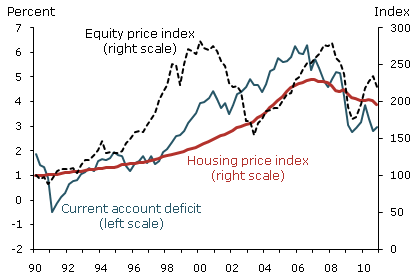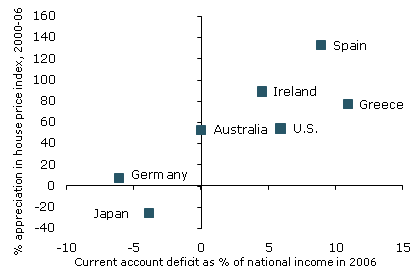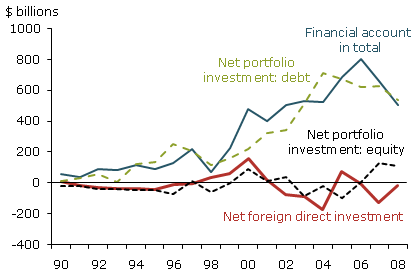Before the global financial crisis of 2007-2009, the United States and several other countries posted large current account deficits. Many of these countries also experienced asset price booms. Evidence suggests the two developments were linked. Rising asset values in the United States permitted households to borrow more easily to boost consumption, while the net sale of debt securities abroad financed current account deficits. The fall in some asset prices since the crisis can make it easier to reduce current account imbalances.
One of the features of the global economy before the financial crisis of 2007–2009 was large imbalances in the current accounts of the United States and several other countries. In 2006, on the eve of the crisis, the U.S. current account deficit reached 6% of national income. Such deficits are worrisome because they require financing through capital inflows from abroad. These can take the form of debt issues or international sales of domestic assets. Each year’s current account deficit adds to the net debt that the United States owes to the rest of the world. At the end of 2010, U.S. international debt exceeded $2.4 trillion, amounting to nearly $8,000 per person.
Before the financial crisis, at the same time U.S. current account deficits were growing rapidly, the prices of assets such as houses and stock boomed. Many economists believe these developments were linked. (For example, see Fratzscher and Straub 2009; Fratzscher, Juvenal, and Sarno 2010; Laibson and Mollerstrom 2010; Gete 2010; and Adam, Kuang, and Marcet 2011.) There are economic reasons why a rise in the value of assets owned by households could prompt a rise in consumption, fueling current account deficits. This suggests that current account imbalances should be taken seriously as warning signs of potential future financial crises. It also suggests that the sharp fall in asset prices stemming from the 2007–2009 financial crisis has served as a mechanism of global financial adjustment, reducing current account deficits to more normal and sustainable levels. This Economic Letter presents empirical data linking U.S. and other current account deficits to asset prices, and explores economic theory on the relationship between the two.
Empirical observations
Figure 1
Deficits, equity prices, and housing prices

Notes: Current account deficit is measured as percentage of nationalincome. Price indexes are for the United States for 1990–2010.
Figure 2
Current account deficits and housing price changes

The current account is the broadest measure of a country’s net exports to the rest of the world. It includes goods and services measured in the trade balance, but also such components as interest, dividends, and foreign aid. Figure 1 shows the U.S. current account deficit widened steadily from 1991 to 2006, reaching over 6% of national output. Since the onset of the financial crisis, the current account deficit has fallen by half.
The United States was by no means alone in running a current account deficit in the years immediately preceding the crisis. Spain and Greece reached deficits of 10% of national income, as shown in Figure 2. It is not a coincidence that countries with large current account deficits experienced significant financial turmoil during the crisis. These current account deficits were mirrored by large current account surpluses in such countries as Germany, as well as countries in eastern Asia and some oil exporters. Figure 2 shows Germany ran a current account surplus of about 6% of national income and Japan of nearly 4% in 2006. Current account deficits in countries such as the United States were financed by large capital inflows from these surplus countries. These capital inflows are visible in the financial accounts of these countries, which track the international sale of assets and debt securities.
The period during which the U.S. current account deficit grew also saw the prices of certain assets appreciate dramatically. Figure 1 shows the run-up in U.S. housing prices in the years before the financial crisis and the rise in stock prices during the 1990s. Taken together, the housing and stock markets largely account for the trend of increasing asset values, which contributed to rising household wealth. Economists disagree whether this asset appreciation reflected expectations about future economic fundamentals such as productivity gains or were the product of financial bubbles. Here I examine how rising asset prices contributed to the global imbalances expressed in the expanding U.S. current account deficit. It is also notable that these asset prices declined precipitously during the financial crisis in 2008, which coincided with a sharp reduction in the U.S. current account deficit.
Just as the United States was not the only country posting a large current account deficit, so too it was not the only country that experienced asset price booms. Figure 2 shows that countries with large current account deficits in 2006 also tended to have larger house price increases. Of course, there are exceptions. For example, China has experienced rapid house price appreciation despite its enormous current account surplus. But, in general, house price appreciation and current account deficits appear to have been positively associated across many countries.
Theoretical explanations
What does economic theory say about the association between the current account and asset prices? One linkage suggested by theory is through wealth effects on consumption. The current account equals the gap between total national income and total national expenditure. Therefore, a rise in private consumption relative to income means that more goods are being imported and fewer goods are available for export.
When the current account is broken down into its accounting components, the rising current account deficit after 1990 is explained predominantly by a fall in private saving, that is, a rise in private consumption relative to income. A much smaller share of the current account deficit is attributable to government borrowing or investment expenditure. Government borrowing was about 1% of GDP in 2007, while the current account deficit was over 5% of GDP. During this period, American households were steadily raising their consumption and reducing saving. During some of this period, household saving rates became negative. It appears that a portion of consumption was financed by tapping rising asset wealth rather than current income.
Textbook economic theory holds that households prefer to maintain a smooth level of consumption across time periods. During each period, they consume more or less a constant portion of their expected lifetime wealth. In principle, an increase in the value of an asset raises household wealth and should lead to a rise in consumption. A rise in the value of stock owned by a household means that some of those equities can be sold to finance a higher level of consumption. Similarly, a rise in the market value of the family home means, in principle, that the family can afford more consumption each year. Of course, households are not literally required to sell part of their homes each year to finance extra consumption. Instead, they can take out loans against their houses to extract some of the rising equity to finance higher consumption.
A second potential mechanism linking asset prices and the current account is the role of collateral. It may be that households wanted for some time to borrow to finance more consumption. However, no bank was willing to lend to them because they didn’t have sufficient collateral to secure their debts against default. In such cases, a rise in home values could give households enough collateral to borrow or increase the size of the loans they were eligible for. As households use their borrowing capacity to raise consumption closer to their desired levels, private saving declines and the current account deficit expands.
Conclusion
Figure 3
U.S. financial account and components, 1990–2008

To what degree were households able to cash in on rising asset values by selling or borrowing off of those assets? Figure 3 shows the components of the U.S. financial account, which tracks the sale of assets used to finance the current account deficit. The dramatic rise in total financial inflows in the mid-2000s was tracked almost fully by a rise in international net sales of debt securities, including government and private-issue securities. The other two main categories, direct foreign investment and international net sales of stock, did not rise in similar fashion to finance the rising current account deficit. In fact, net trade in those two categories was negative for most of those years. That indicates there was a net outflow of capital in those two categories. Thus, foreign direct investment and international sale of U.S. equities were not part of the capital inflow that financed the current account deficit.
This pattern reflects the tendency of U.S. investors to purchase higher-risk, higher-yield foreign assets, such as international stocks, while selling lower-risk, lower-yield assets such as debt securities to foreigners. The lower volume of net trade in stock and direct investment suggests that consumers were not able to cash in on rising asset values by directly selling assets in those categories abroad. Rather, it appears that households used their higher-value assets as collateral to gain access to the U.S. financial market and take out loans. Some of those loans made their way overseas in the form of net sales of debt securities.
It appears that the rise in U.S. stock and housing prices was in part to blame for the fall in national saving and the rise in the current account deficit. This may help explain why the collapse of the prices of those assets was so potent in reducing the U.S. current account deficit. It may be that the sharp fall of the housing and stock markets was the mechanism needed to reduce large current account imbalances not only in the United States, but in other countries that had taken advantage of rising asset prices to finance consumption. In this way, falling asset prices have brought current account deficits back to more sustainable levels and helped restore a better global financial balance.
References
Adam, Klaus, Pei Kuang, and Albert Marcet. 2011. “House Price Booms and the Current Account.” Forthcoming in NBER Macroeconomics Annual 26.
Fratzscher, Marcel, Luciana Juvenal, and Lucio Sarno. 2010. “Asset Prices, Exchange Rates, and the Current Account.” European Economic Review 54, pp. 643–658.
Fratzscher, Marcel, and Roland Straub. 2009. “Asset Prices and Current Account Fluctuations in G-7 Economies.” IMF Staff Papers 56(3), pp. 633–654.
Gete, Pedro. 2010. “Housing Markets and Current Account Dynamics.” Unpublished manuscript, Georgetown University.
Laibson, David, and Johanna Mollerstrom. 2010. “Capital Flows, Consumption Booms, and Asset Bubbles: A Behavioural Alternative to the Savings Glut Hypothesis.” NBER Working Paper 15759, forthcoming in the Economic Journal.
Opinions expressed in FRBSF Economic Letter do not necessarily reflect the views of the management of the Federal Reserve Bank of San Francisco or of the Board of Governors of the Federal Reserve System. This publication is edited by Anita Todd and Karen Barnes. Permission to reprint portions of articles or whole articles must be obtained in writing. Please send editorial comments and requests for reprint permission to research.library@sf.frb.org